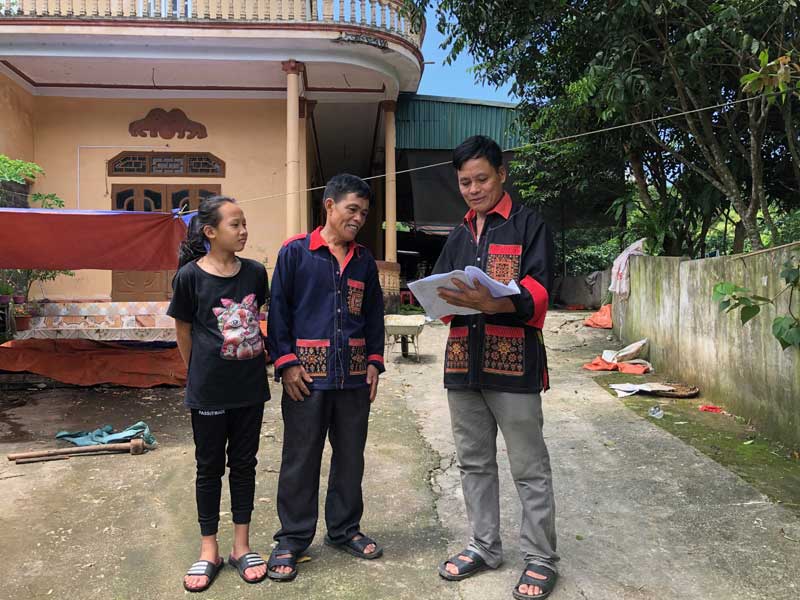
(HBO) - Tu Son commune is located in the northwest of Kim Boi district. There are 5 ethnic groups living together, in which, the Dao ethnic group accounts for 21% including Dao Tien and Dao Quan Chet.
 The officers in Ha Son
hamlet, Tu Son commune (Kim Boi) have been propagandizing and mobilizing the
people to build cultural lifestyles, emulating production - business and
economic development.
The officers in Ha Son
hamlet, Tu Son commune (Kim Boi) have been propagandizing and mobilizing the
people to build cultural lifestyles, emulating production - business and
economic development.
Promoting the patriotic tradition, Dao ethnic people in Tu Son
commune have always been making efforts for the socio-economic development. Up
till now, the systems of electricity, roads, schools and stations in the
hamlets have basically met the needs of the people. The people have abandoned
the shifting cultivation and nomadic life. The solidly built houses have
replaced the crooked houses with dilapidated roofs. The green of the crops has
been covering the wasteland. Almost every home in the helmet has a TV, a
motorbike, those who are better still have refrigerators, plows, even cars.
Mr. Ly Van Chung, the Chairman of the Fatherland Front of Tu
Son Commune says that currently there are 160 Dao ethnic households living in 4
hamlets: Ha Son, Kim Bac, Thung Dao and Group 3in Hop Nhat hamlet. Thanks to
the promotion of propaganda and advocacy, the customs such as funerals,
weddings and festivals of the Dao people have been shortened and reduced the
cost of organization. The order and security in the area have been remained
stable. The cultural life is built, which is synonymous with the socio-economic
development. Through the support policies of the province, the district and the
commune, the people have the opportunity to access the basic social services
and get loans for economic development.
Up to now, the average income has
reached over 19 million VND a person every year. There are a lot typical
examples of those who are good at making business in the area such as Mr. Ly Sinh Toan's
household in Ha Son hamlet with an income of over 120 million dongs a year; Mr.
Duong Tri Hai in Ha Son hamlet with an income of over 100 million VND a year;
Mr. Trieu Phuc Thanh in Thung Dao Bac hamlet earning nearly 150 million VND a
year.
The Department of Education and Training of Hoa Binh province held a conference on March 18 to review the performance of the "Safe and Happy School" Project and set out tasks for 2025. The project, funded by the Taiwan Fund for Children and Families (TFCF), aims to create a safe, inclusive, and supportive learning environment for students. The event saw the attendance of representatives from the TFCF and 26 beneficiary schools.
With over 70% of their workers being women, trade unions across industrial parks (IPs) in Hoa Binh have been actively safeguarding their legal rights and interests while implementing initiatives to improve their income and well-being.
In recent years, the Hoa Binh provincial General Hospital has continuously innovated itself and improved the quality of medical services to meet the increasing needs of local people. With substantial investments in infrastructure and modern equipment, along with a team of highly qualified doctors and nurses, the hospital has gradually established itself as one of the leading medical units in the Northwestern region and a trusted destination for healthcare for people inside and outside the province.
From mastering the fundamentals of programming to achieving national recognition, the Programming Club of the Le Van Tam Primary School (STAR LVT28) in Hoa Binh city has made remarkable strides in the field of robotics.
The Ho Chi Minh Communist Youth Union Committee and the Vietnam Youth Federation chapter of Hoa Binh province organised a programme on March 12 to launch the "Digital Literacy" movement and an online quiz on the resolutions of the Vietnam Youth Federation congresses at all levels, as well as the Politburo's Resolution No. 57-NQ/TW on breakthroughs in the development of science, technology, innovation, and national digital transformation.
As climate change grows more unpredictable, the development of production forests has become essential - not just for economic growth, but for safeguarding the environment and maintaining ecosystem balance. By boosting local incomes, curbing natural disasters, preventing soil erosion, and protecting water resources, these forests play a crucial role in sustainable development.



 The officers in Ha Son
hamlet, Tu Son commune (Kim Boi) have been propagandizing and mobilizing the
people to build cultural lifestyles, emulating production - business and
economic development.
The officers in Ha Son
hamlet, Tu Son commune (Kim Boi) have been propagandizing and mobilizing the
people to build cultural lifestyles, emulating production - business and
economic development.